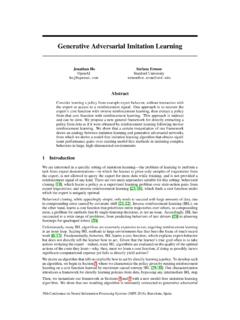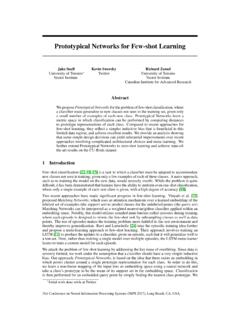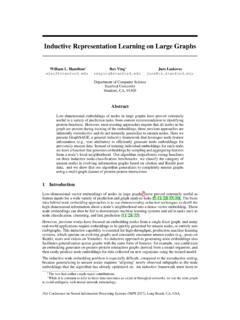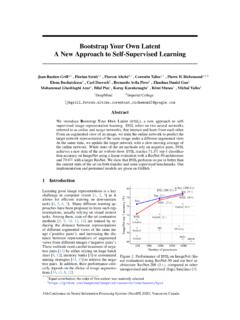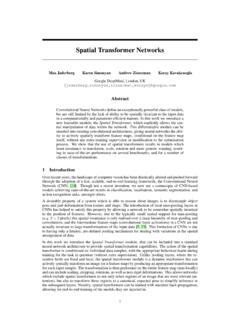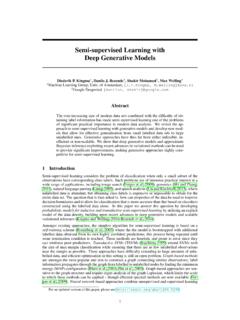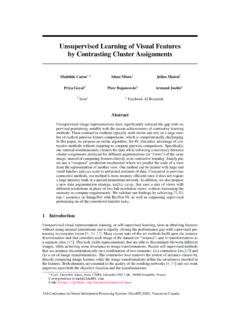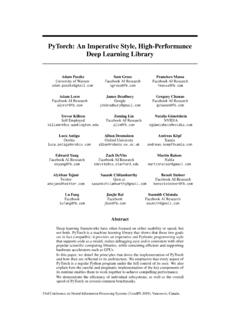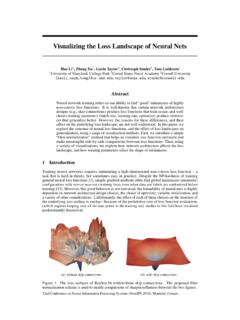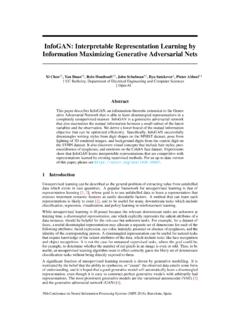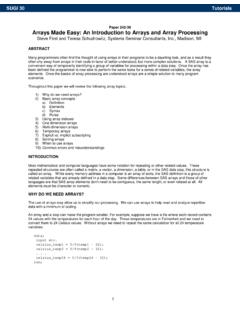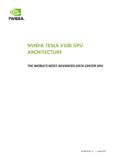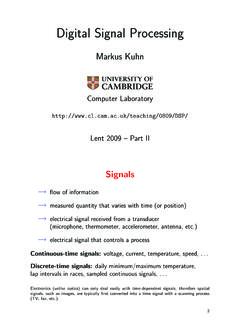Transcription of Gradient Episodic Memory for Continual Learning
1 Gradient Episodic Memory for Continual LearningDavid Lopez-Paz and Marc Aurelio RanzatoFacebook Artificial Intelligence major obstacle towards AI is the poor ability of models to solve new prob-lems quicker, and without forgetting previously acquired knowledge. To betterunderstand this issue, we study the problem ofcontinual Learning , where the modelobserves, once and one by one, examples concerning a sequence of tasks. First,we propose a set of metrics to evaluate models Learning over a continuum of metrics characterize models not only by their test accuracy, but also in termsof their ability to transfer knowledge across tasks.
2 Second, we propose a modelfor Continual Learning , called Gradient Episodic Memory (GEM) that alleviatesforgetting, while allowing beneficial transfer of knowledge to previous tasks. Ourexperiments on variants of the MNIST and CIFAR-100 datasets demonstrate thestrong performance of GEM when compared to the IntroductionThe starting point in supervised Learning is to collect atraining setDtr={(xi,yi)}ni=1, whereeachexample(xi,yi)is composed by afeature vectorxi X, and atarget vectoryi Y. Mostsupervised Learning methods assume that each example(xi,yi)is an identically and independentlydistributed (iid) sample from afixedprobability distributionP, which describes a single Learning goal of supervised Learning is to construct a modelf:X Y, used to predict the target vectorsyassociated to unseen feature vectorsx, where(x,y) P.
3 To accomplish this, supervised learningmethods often employ the Empirical Risk Minimization (ERM) principle [Vapnik, 1998], wherefis found by minimizing1|Dtr| (xi,yi) Dtr`(f(xi),yi), where`:Y Y [0, )is a loss functionpenalizing prediction errors. In practice, ERM often requires multiple passes over the training is a major simplification from what we deem as human Learning . In stark contrast to learningmachines, Learning humans observe data as an ordered sequence, seldom observe the same exampletwice, they can only memorize a few pieces of data, and the sequence of examples concerns differentlearning tasks.]
4 Therefore, the iid assumption, along with any hope of employing the ERM principle,fall apart. In fact, straightforward applications of ERM lead to catastrophic forgetting [McCloskeyand Cohen, 1989]. That is, the learner forgets how to solve past tasks after it is exposed to new paper narrows the gap between ERM and the more human-like Learning description above. Inparticular, our Learning machine will observe,example by example, thecontinuum of data(x1,t1,y1),..,(xi,ti,yi),..,(xn,tn,y n),(1)where besides input and target vectors, the learner observesti T, atask descriptoridentifyingthe task associated to the pair(xi,yi) Pti.
5 Importantly, examples are not drawn iid from a fixedprobability distribution over triplets(x,t,y), since a whole sequence of examples from the currenttask may be observed before switching to the next task. The goal ofcontinual learningis to constructa modelf:X Table to predict the targetyassociated to a test pair(x,t), where(x,y) Pt. Inthis setting, we face challenges unknown to ERM:31st Conference on Neural Information Processing Systems (NIPS 2017), Long Beach, CA, input data: the continuum of data is notiidwith respect to any fixed probabilitydistributionP(X,T,Y)since, once tasks switch, a whole sequence of examples from thenew task may be forgetting: Learning new tasks may hurt the performance of the learner atpreviously solved Learning : when the tasks in the continuum are related, there exists an opportunityfor transfer Learning .
6 This would translate into faster Learning of new tasks, as well asperformance improvements in old rest of this paper is organized as follows. In Section 2, we formalize the problem of continuallearning, and introduce a set of metrics to evaluate learners in this scenario. In Section 3, wepropose GEM, a model to learn over continuums of data that alleviates forgetting, while transferringbeneficial knowledge to past tasks. In Section 4, we compare the performance of GEM to thestate-of-the-art. Finally, we conclude by reviewing the related literature in Section 5, and offer somedirections for future research in Section 6.
7 Our source code is available A Framework for Continual LearningWe focus on thecontinuumof data of(1), where each triplet(xi,ti,yi)is formed by a feature vectorxi Xti, a task descriptorti T, and a target vectoryi Yti. For simplicity, we assume that thecontinuum islocally iid, that is, every triplet(xi,ti,yi)satisfies(xi,yi)iid Pti(X,Y).While observing the data(1)example by example, our goal is to learn a predictorf:X T Y,which can be queriedat any timeto predict the target vectoryassociated to a test pair(x,t), where(x,y) Pt. Such test pair can belong to a task that we have observed in the past, the current task, ora task that we will experience (or not) in the descriptorsAn important component in our framework is the collection of task descriptorst1.
8 ,tn T. In the simplest case, the task descriptors are integersti=i Zenumerating thedifferent tasks appearing in the continuum of data. More generally, task descriptorsticould bestructured objects, such as a paragraph of natural language explaining how to solve thei-th task. Richtask descriptors offer an opportunity for zero-shot Learning , since the relation between tasks could beinferred using new task descriptors alone. Furthermore, task descriptors disambiguate similar learningtasks. In particular, the same inputxicould appear in two different tasks, but require different descriptors can reference the existence of multiplelearning environments, or provide additional(possibly hierarchical)contextual informationabout each of the examples.
9 However, in this paperwe focus on alleviating catastrophic forgetting when Learning from a continuum of data, and leavezero-shot Learning for future , we discuss the training protocol and evaluation metrics for Continual Protocol and Evaluation MetricsMost of the literature about Learning over a sequence of tasks [Rusu et al., 2016, Fernando et al.,2017, Kirkpatrick et al., 2017, Rebuffi et al., 2017] describes a setting where i) the number of tasks issmall, ii) the number of examples per task is large, iii) the learner performs several passes over theexamples concerning each task, and iv) the only metric reported is the average performance across alltasks.
10 In contrast, we are interested in the more human-like setting where i) the number of tasks islarge, ii) the number of training examples per task is small, iii) the learner observes the examplesconcerning each task only once, and iv) we report metrics that measure both transfer and , at training time we provide the learner with only one example at the time (or a smallmini-batch), in the form of a triplet(xi,ti,yi). The learner never experiences the same exampletwice, and tasks are streamed in sequence. We do not need to impose any order on the tasks, since afuture task may coincide with a past monitoring its performance across tasks, it is also important to assess the ability of the learnertotransferknowledge.
